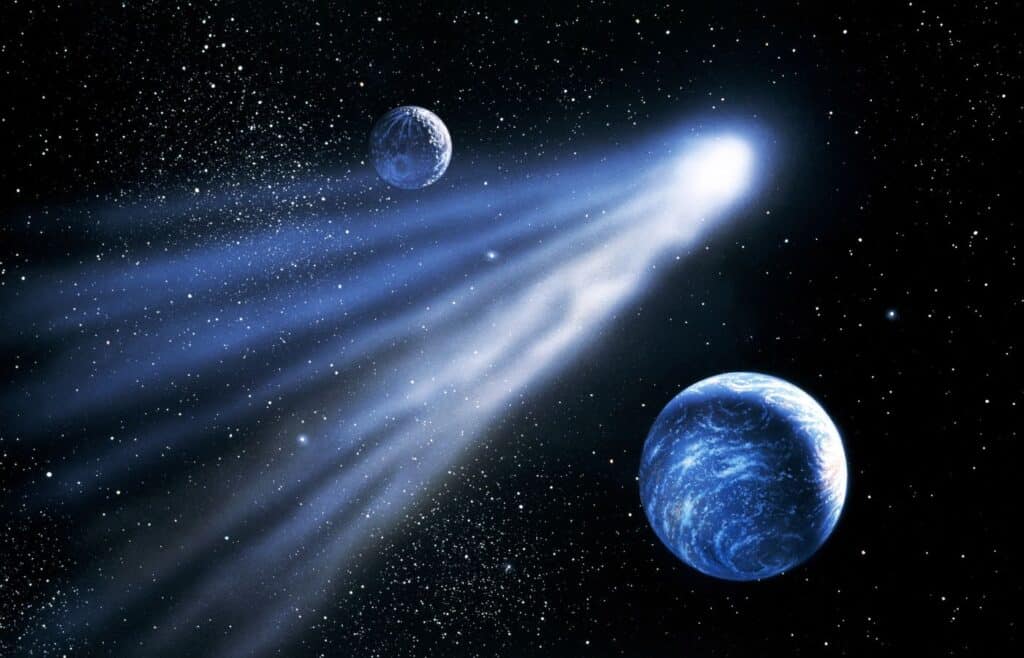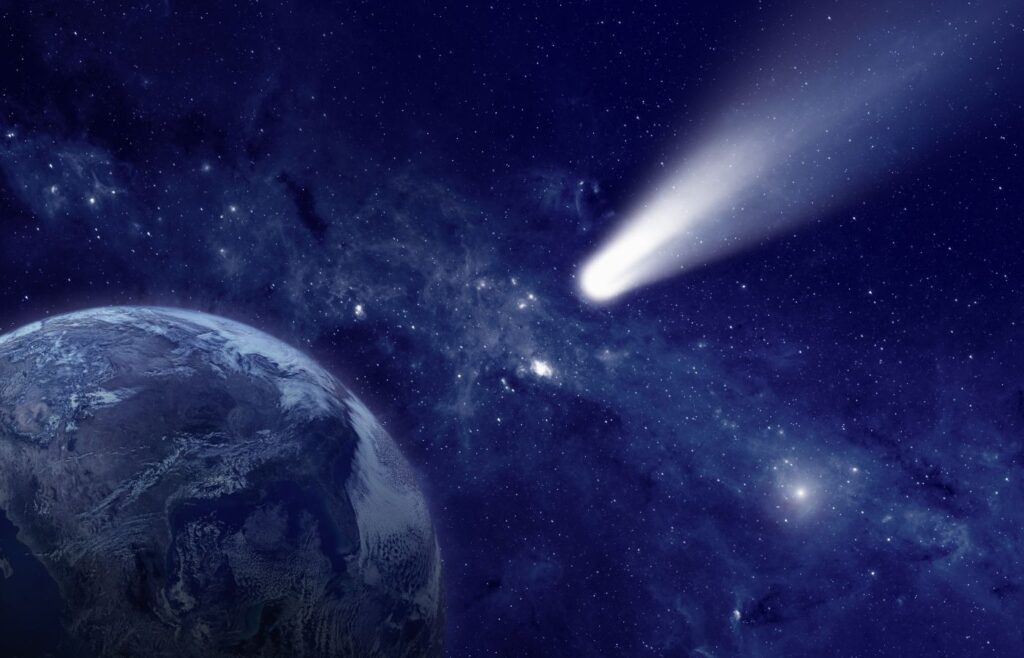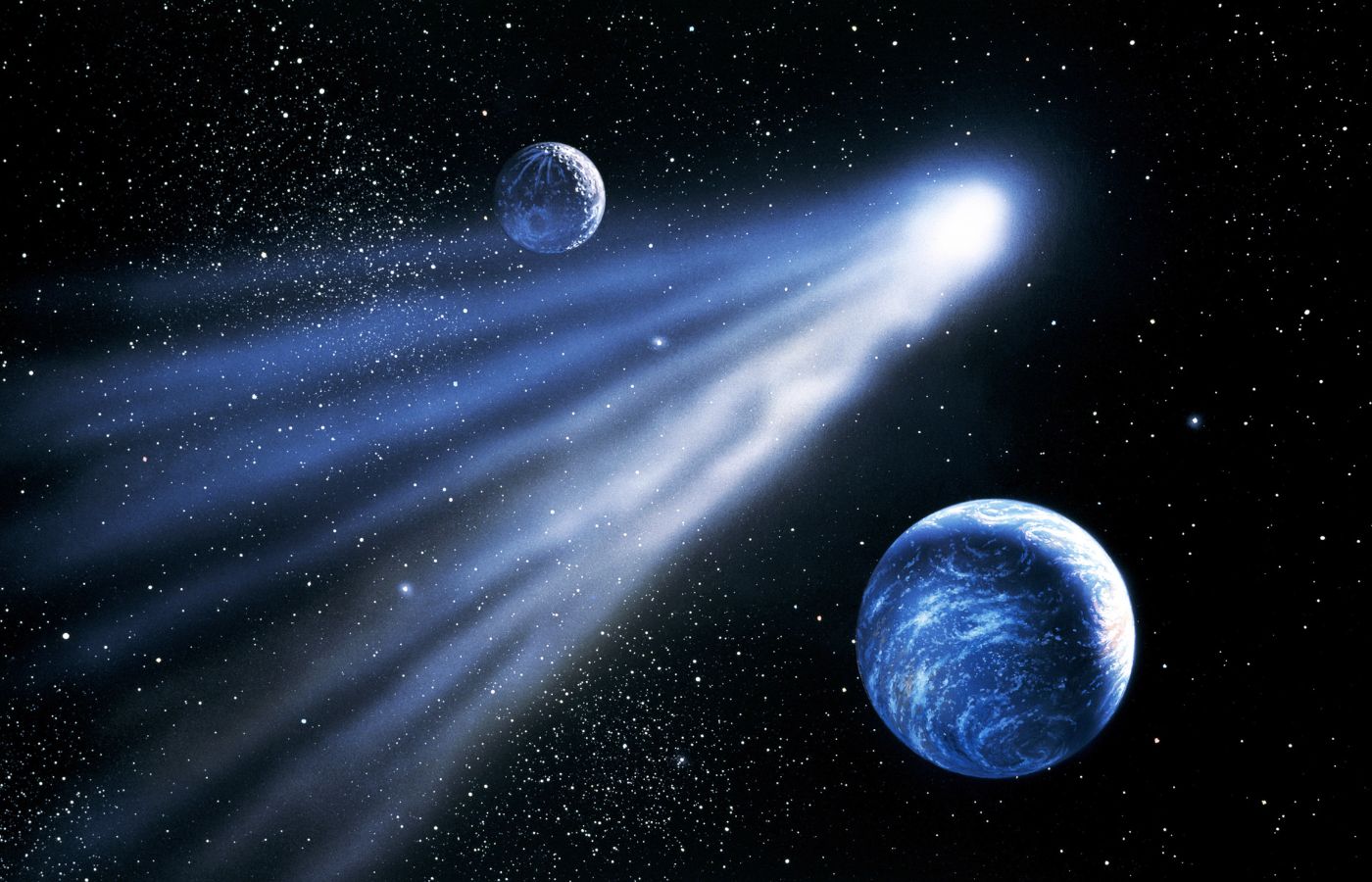
Welcome, young astronomers and curious minds! Today, we’re setting our sights on those mesmerizing wonders of the night sky: comets. These celestial travelers have fascinated humans for centuries with their icy hearts and firey dust tails.
Beyond their mesmerizing appearance, comets hold valuable clues about the formation of our solar system and the building blocks of life itself. Let’s dive deep into the fascinating world of comets, exploring their origins, interesting facts, comet names, and the remarkable journeys they take through space.
Did you know? NASA has studied comets up close, and if your kids love space missions, they’ll be amazed by what’s on display at Kennedy Space Center. Here’s our honest review of Kennedy Space Center.
Comet Facts
The word “Comet” comes from an old Greek word, “kometes,” which means “long hair star.”
While comets don’t have any actual hair, this is a great description of what comets can look like to humans.
Comets are made of frozen water, dust, & frozen gas.
So, what are comets? Imagine comets as giant dirty snowballs hurtling through space. They are large space objects made of a mixture of frozen water, dust particles, and frozen gasses including carbon dioxide, methane, and ammonia.
They have an icy core.
At their core, they are made of solid ice. This ice core is called the comet nucleus. If you’ve heard of the nucleus of a biological cell, you might be thinking of something small. However, the nucleus of a comet can be several kilometers wide, or the size of a small town.
Comets looks like streaks because they’re melting.
To the naked eye, comets look like shimmering bright objects streaking across the night sky. They look like streaks because as comets venture closer to the Sun, they light up as the ice and gases melt and burn.
Their bright head is called a coma.
This forms a bright head called a coma and a long, glowing dust tail (also called an ion tail) that stretches across the sky behind them as they journey through the cosmos.

Not all bright objects in the sky are comets.
However, not all bright objects in the sky are comets. While comets can be made of some small rocky particles, they are mostly made of ice. Space objects like meteors or asteroids are mostly made of rocky material and are not icy bodies. Of course, astronomical events like meteor showers are spectacular, too, but today we are talking about comets!
Comets come from the Kuiper Belt and the Oort Cloud.
Comets come from two main regions in our solar system where there are lots of comets: the Kuiper Belt and the Oort Cloud. The orbit of a comet takes it from these origin places to places all over the solar system.
The Kuiper Belt is a massive, distant region near Neptune filled with icy objects. It was named after astronomer Gerard Kuiper, who is one of several scientists who suspected it existed. Scientists are only just beginning to explore this region.
The Oort Cloud is even farther away, and it is a vast shell of icy objects surrounding the solar system. The Oort Cloud was discovered in 1950 by the Dutch astronomer Jan Oort, after whom it is named.
Scientists have gotten very close to comets.
While scientists can’t physically walk on comets, they have gotten very close to comets during several space missions. Scientists can also study photos of comets and measure the light and radiation that they put out.
The closest picture ever taken was of Halley’s Comet.
In 1986, The European Space Agency’s Giotto Mission took the closest pictures of a comet ever taken. The pictures were of Halley’s Comet, and the pictures showed a solid object with long streams of gas and dust shooting out of it into space.
NASA has dust samples from a real comet!
In 2004, NASA’s Stardust Mission was the first mission to collect comet dust samples and bring them back to Earth to be studied. They took cosmic dust samples from the coma of Comet Wild-2.
A comet can stretch for millions of miles through space.
Comets lead a dynamic existence, shaped by their orbit around the Sun. As a comet orbits near the inner solar system, solar radiation from the sun heats up the icy nucleus, transforming the ingredients from solid to gas.
This process of heating and releasing particles creates the comet’s tail and coma, which can stretch for millions of miles through space.
Comets are categorized by their orbital periods
The term “orbital period” refers to the amount of time it takes a comet to orbit the Sun.
Some comets, like Halley’s Comet, have highly elliptical orbits that bring them close to the Sun and then hurl them back into the depths of space, while others, such as long-period comets, make rare and unpredictable appearances.
Some comets, known as short-period comets, have relatively brief orbits and regularly return to the inner solar system. They orbit the sun in less than 200 years.
Halley’s Comet can be seen from earth every 75-79 years.
Halley’s Comet is a famous example of a short-period comet, as it comes close enough to Earth that we can see it with the naked eye approximately every 75–79 years.
Some comets are only seen from earth every 1000 years.
Other comets, called long-period comets, have a larger orbit through space, so they only make rare and unpredictable appearances. They are only seen every 200 to 1000 years and are suspected to come from longer distances away in the Oort Cloud.
Comets give scientists a window to the past.
Studying comets offers a unique window into the distant past, allowing scientists to unravel the mysteries of solar system formation and the delivery of water ice and organic material to early Earth. Some researchers even speculate that organic compounds necessary for life were originally brought to Earth when comets impacted the surface.

By unraveling the secrets hidden within these icy rocks, scientists hope to unlock the cosmic origins of life on Earth and the formation of the solar system itself.
Halley’s Comet appears in ancient manuscripts.
Throughout history, famous comets have captivated the minds and hearts of people across cultures and civilizations. They have inspired awe, wonder, and sometimes fear in the hearts of observers. Scientists give different names to comets to identify them and make it easier to study them.
Perhaps the most famous comet in history is Halley’s Comet, which, as we mentioned above, is a short-period comet. Halley’s Comet was named after the English astronomer Edmond Halley, who successfully predicted its return in 1758 based on previous observations. Halley’s Comet is famous because its orbit is frequent and predictable, allowing humans to document its history closely. Long before 1758, Halley’s comet appears in ancient manuscripts, artworks, and historical accounts throughout human history.
The Hale-Bopp Comet could be seen from earth for 18 months!
Another famous comet is the Hale-Bopp Comet, which graced the night skies in 1997 with its dazzling display. This comet made history when it was visible to the naked eye for a record-breaking 18 months, making it the most widely observed comet in history. Its majestic tail stretched across the night sky for millions to see.
How Can You Watch for Comets?
Ready to embark on your own comet-watching adventure? Here are some tips to enhance your viewing experience and make the most of your stargazing sessions:
1. Plan Your Timing
While you might get lucky and see a comet on a random night, the chances are rare. To help increase your chances, there are astronomical events calendars and online resources to help you stay updated on upcoming comet sightings and other celestial phenomena.
2. Check the Weather
Factors like clouds, smog, and city light pollution can make it hard to see the night sky.
To increase your chances of a comet sighting, plan your stargazing outings during clear nights in areas with minimal light pollution for the best viewing conditions. Choose a viewing location away from city lights and tall buildings to maximize visibility.
Parks, nature reserves, or rural areas offer ideal settings for observing comets and other celestial objects.
3. Bring Viewing Equipment if You Can
While comets are often visible to the naked eye, binoculars or a small telescope can improve your viewing experience. They help you visually zoom in and see finer details, such as the comet’s nucleus and tail. If you can, find a pair of quality binoculars or a beginner-friendly telescope to explore the night sky easily.
4. Have Patience and Persistence!
Stargazing requires patience and persistence, especially when waiting for a comet to appear. Be prepared to spend some time outdoors, allowing your eyes to adjust to the darkness and scanning the heavens for celestial treasures. Don’t get discouraged if you don’t see a comet on your first try! Keep it up, and eventually, you will see your first comet. You’ll be glad you kept trying!
5. Remember Safety First
Remember to dress warmly and bring essential supplies like snacks, water, and a flashlight if you’ll be outside long.
While looking at the night sky, stay alert and aware of your surroundings here on Earth. Flashlights with red-tinted or covered lenses can help keep you safe at night while preserving your night vision. Never go alone, and keep track of where you are so you don’t get lost.
Remember, always prioritize safety when stargazing, especially when venturing into remote or unfamiliar areas.
Comet Facts: Key Takeaways
We hope you’ve gained a newfound appreciation for comets’ awe-inspiring beauty and scientific significance.
From their humble origins in the outer solar system to their majestic appearances in Earth’s skies, comets continue to enchant and inspire us. Seeing the tail of a comet is something you’ll never forget!
Whether you’re venturing out with a telescope or simply marveling at the wonders of the universe from your backyard, remember that the cosmos is full of mysteries waiting to be discovered. So, keep looking up, stay curious, and never stop exploring the cosmic wonders that surround us all.
Until next time, may your adventures under the stars be filled with wonder and discovery!
Related Posts:
50 Surprising Facts About Mars For Kids
50 Surprising Facts About Neptune For Kids
50 Mind-Blowing Hurricane Facts For Kids
25 Mind-Blowing Rainbow Facts For Kids
Calie Herbst, Editor-in-Chief of Milwaukee With Kids, has spent over a decade combining her experiences as a parent of three to create a hub for Milwaukee’s family adventures.
Her decade-long teaching career in Milwaukee Public Schools and academic background, including a Master’s in Teaching from Marquette University and dual B.A.s in Sociology and Spanish from the University of Wisconsin – Madison, fuel her passion for inclusive and engaging family content.
Calie is also a recognized voice in local media, contributing to WISN Channel 12 News, WTMJ Wisconsin Morning News, Fox 6’s Real Milwaukee, and B93.3.
Discover more about Calie’s journey and editorial approach on her About Page and Editorial Policy Page.









